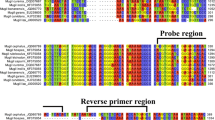Abstract
Large yellow croaker (Larimichthys crocea) and redlip yellow croaker (L. polyactis) are commonly consumed species in fisheries markets in East Asian countries. They have wide differences of price due to consumer preferences for L. polyactis. However, it is difficult to identify the species based on the appearance of both species from the general public. In this study, a real-time polymerase chain reaction (PCR) kit was designed to distinguish these two species. Speciescommon primer pairs were designed, and two speciesspecific probes were designed with sequences that were 2 bp different. The L. crocea target probe was modified using HEX dye, whereas the L. polyactis was modified using FAM dye. These primer pairs and probes worked in a single reaction. Based on the confirmation of a simple peak image, both species were sufficiently distinguished. The PCR kit developed in our study can be suggested as a good tool to distinguish both fish species for consumer as well as producer. In addition, the species-specific probes can be used as the biomarker, which applies to the lab-on-a-chip technology.
Similar content being viewed by others
References
Lee, W.S. et al. Development of a DNA microarray for species identification of quarantine aphids. Pest. Manag. Sci. 69, 1399–1406 (2013).
Park, J.Y. et al. Development of a DNA chip to identify the place of origin of hairtail species. BioChip J. 7, 136–142 (2013).
Kim, J.H. et al. Species identification of filefishes (Monacanthidae) using DNA microarray in Korean marketplace. BioChip J. 5, 229–235 (2011).
Park, J.Y. et al. A DNA microarray for species identification of cetacean animals in Korean water. BioChip J. 4, 197–203 (2010).
Hebert, P.D.N., Ratmasimgham, S. & de Waard, J.R. Barcoding animal life: cytochrome c oxidase subunit 1 divergences among closely related species. P. R. Soc. Lond. Ser. B Biol. Sci. 270(suppl. 1), S96–S99 (2003).
Zhang, J. & Hanner, R. Molecular approach to the identification of fish in the South China Sea. PLoSOne. 7, e30621 (2012).
Kochzius, M. et al. Identifying dishes through DNA barcodes and microarrays. PLoS One. 5, e12620 (2010).
Folmer, O., Black, M., Hoeh, W., Lutz, R. & Vrijenhoek, R. DNA primers for amplification of mitochondrial cytochrome C oxidase subunit 1 from diverse metazoan invertebrates. Mol. Mar. Biol. Biotech. 3, 294–299 (1994).
Hebert, P.D.N., Cywinska, A., Ball, S.L. & de Waard, J.R. Biological identifications through DNA barcodes. Proc. R. Doc. Lond. B. 270, 313–321 (2003).
Michael, T.M., Michael, B., Gregory, T.R. & Vogler, A.P. DNA-based species delineation in ropical beetles using mitochondrial and nuclear markers. Phil. Trans R. Soc. B. 360, 1925–1933 (2005).
Park, Y.C. et al. Development of detection method for Niphon spinosus, Epinephelus brunrus and Epinephelus septemfasciatus using 16S rRNA gene. Korean J. Food Sci. Technol. 45, 1–7 (2013).
You, J., Huang, L., Zhuang, J. & Mou, Z. Speciesspecific multiplex Real-time PCR assay for identification of Deer and common domestic animals. Food Sci. Biotechnol. 23, 133–139 (2014).
Mafra, I., Ferreira, I.P.L.V.O. & Oliveira, M.B.P. Food authentication by PCR-based methods. Eur. Food Res. Technol. 277, 649–665 (2008).
Fajardo, V., Gonzalez, I., Rojas, M., Gracia, T. & Martin, R. A review of current PCR-based methodologies for the authentication of meats from game animal species. Trends Food Sci. Technol. 21, 408–421 (2010).
Volkhard, H. Fluorescence Resonance Energy Transfer. Principles of Computational Cell Biology. Weinheim: Wiley-VCH. 202 (2008).
Horváth, Á., Petö, Z., Urbán, E., Vágvölgyi, C. & Somogyvári, F. A novel, multiplex, real-time PCRbased approach for the detection of the commonly occurring pathogenic fungi and bacteria. BMC Microbiol. 13, 300 (2013).
Tantrawatpan, C. et al. Early detection of Trichinella spiralis in muscle of infected mice by real-time fluorescence resonance energy transfer PCR. Vector Borne Zoonotic Dis. 13, 674–681 (2013).
Bergmann, O. et al. Identification of cardiomyocyte nuclei and assessment of ploidy for the analysis of cell turnover. Exp. Cell. Res. 2, 188–194 (2011).
Sun, N. et al. MRP2 and GSTP1 polymorphisms and chemotherapy response in advanced non-small cell lung cancer. Cancer Chemotherapy and Pharmacology 3, 437–446 (2010).
Wang, M. et al. Genetic Variants in miRNAs Predict Bladder Cancer Risk and Recurrence. Cancer Res. 23, 6173–6182 (2012).
Tamura, K., Nei, M. & Kumar, S. Prospects for inferring very large phylogenies by using the neighbor-joining method. PNAS 101, 11030–11035 (2004).
Tamura, K., Dudley, J., Nei, M. & Kumar, S. MEGA4: Molecular Evolutionary Genetics Analysis (MEGA) software version 4.0. Molecular Biology and Evolution 24, 1596–1599 (2007).
Simon, C., Franke, A. & Martin, A. The polymerase chain reaction: DNA extraction and amplification. In: Hewitt, G.M. et al. ed. Molecular Techniques in Taxonomy. NATO ASI Series H57, 329–355 (1991).
Author information
Authors and Affiliations
Corresponding author
Rights and permissions
About this article
Cite this article
Cho, H., Kim, JH., Lee, W.S. et al. Development of molecular detection kit for Larimichthys crocea and Larimichthys polyactis . BioChip J 8, 148–153 (2014). https://doi.org/10.1007/s13206-014-8210-3
Received:
Accepted:
Published:
Issue Date:
DOI: https://doi.org/10.1007/s13206-014-8210-3




